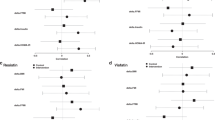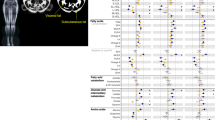Abstract
Glycine (GLY) is a substrate for a wide range of metabolic processes. Several preclinical and adult studies demonstrated inverse associations of GLY with obesity, cardiovascular disease (CVD) and diabetes. However, little evidence is available on relationships between GLY and CVD risk in children. We assessed links between circulating GLY and biomarkers of CVD in children with obesity. Participants included both male and females with normal weight (NW, n = 6) and obesity (OB, n = 15), with age 14–18 years and Tanner stage >IV. Concentrations of GLY, branched chain amino acids (BCAA), and 25-hydroxy vitamin-D [25(OH)D], glucose, insulin, adiponectin, high sensitivity C-reactive protein (hs-CRP), and interleukin-6 (IL-6) were measured using established techniques, and body composition by DXA. Homeostatic model assessment for insulin resistance (HOMA-IR) was calculated. Our study identified major relationships of GLY (p-value < 0.01 for all) of GLY with visceral fat (r2 = 0.40), BCAA (r2 = 0.44), HOMA-IR (r2 = 0.33), 25(OH)D (r2 = 0.48), IL-6 (r2 = 0.46) and adiponectin (r2 = 0.39). Given that CVD progression is a continuum and the disease itself is not present in children and biomarkers are typically used to monitor CVD in children, the links between GLY and biomarkers of CVD provide evidence for the first time of a potential role for GLY in CVD in children with obesity.
This is a preview of subscription content, access via your institution
Access options
Subscribe to this journal
Receive 12 print issues and online access
$259.00 per year
only $21.58 per issue
Buy this article
- Purchase on Springer Link
- Instant access to full article PDF
Prices may be subject to local taxes which are calculated during checkout

Similar content being viewed by others
Data availability
The datasets generated during and/or analyzed during the current study are available from the corresponding author on reasonable request.
References
White PJ, Lapworth AL, McGarrah RW, Kwee LC, Crown SB, Ilkayeva O, et al. Muscle-liver trafficking of BCAA-derived nitrogen underlies obesity-related glycine depletion. Cell Rep. 2020;33:108375.
Tan HC, Hsu JW, Tai ES, Chacko S, Wu V, Lee CF, et al. De novo glycine synthesis is reduced in adults with morbid obesity and increases following bariatric surgery. Front Endocrinol. 2022;13:900343.
Alves A, Bassot A, Bulteau AL, Pirola L, Morio B. Glycine metabolism and its alterations in obesity and metabolic diseases. Nutrients. 2019;11:1356.
Sekhar RV, McKay SV, Patel SG, Guthikonda AP, Reddy VT, Balasubramanyam A, et al. Glutathione synthesis is diminished in patients with uncontrolled diabetes and restored by dietary supplementation with cysteine and glycine. Diabetes Care. 2011;34:162–7.
Rom O, Liu Y, Liu Z, Zhao Y, Wu J, Ghrayeb A, et al. Glycine-based treatment ameliorates NAFLD by modulating fatty acid oxidation, glutathione synthesis, and the gut microbiome. Sci Transl Med. 2020;12:eaaz2841.
Ruiz-Ramírez A, Ortiz-Balderas E, Cardozo-Saldaña G, Diaz-Diaz E, El-Hafidi M. Glycine restores glutathione and protects against oxidative stress in vascular tissue from sucrose-fed rats. Clin Sci (London, England: 1979). 2014;126:19–29.
Takashina C, Tsujino I, Watanabe T, Sakaue S, Ikeda D, Yamada A, et al. Associations among the plasma amino acid profile, obesity, and glucose metabolism in Japanese adults with normal glucose tolerance. Nutr Metab (Lond). 2016;13:5.
Imenshahidi M, Hossenzadeh H. Effects of glycine on metabolic syndrome components: a review. J Endocrinol Investig. 2022;45:927–39.
Glynn EL, Piner LW, Huffman KM, Slentz CA, Elliot-Penry L, AbouAssi H, et al. Impact of combined resistance and aerobic exercise training on branched-chain amino acid turnover, glycine metabolism and insulin sensitivity in overweight humans. Diabetologia. 2015;58:2324–35.
Adeva-Andany M, Souto-Adeva G, Ameneiros-Rodríguez E, Fernández-Fernández C, Donapetry-García C, Domínguez-Montero A. Insulin resistance and glycine metabolism in humans. Amino Acids. 2018;50:11–27.
Thalacker-Mercer AE, Ingram KH, Guo F, Ilkayeva O, Newgard CB, Garvey WTBMI. RQ, diabetes, and sex affect the relationships between amino acids and clamp measures of insulin action in humans. Diabetes. 2014;63:791–800.
Ding Y, Svingen GF, Pedersen ER, Gregory JF, Ueland PM, Tell GS, et al. Plasma glycine and risk of acute myocardial infarction in patients with suspected stable angina pectoris. J Am Heart Assoc. 2015;5:e002621.
Venkatesh R, Srinivasan K, Singh SA. Effect of arginine:lysine and glycine:methionine intake ratios on dyslipidemia and selected biomarkers implicated in cardiovascular disease: a study with hypercholesterolemic rats. Biomed Pharmacother Biomed Pharmacother. 2017;91:408–14.
El Hafidi M, Pérez I, Zamora J, Soto V, Carvajal-Sandoval G, Baños G. Glycine intake decreases plasma free fatty acids, adipose cell size, and blood pressure in sucrose-fed rats. Am J Physiol Regul Integr Comparat Physiol. 2004;287:R1387–93.
Cosentino RG, Churilla JR, Josephson S, Molle-Rios Z, Hossain MJ, Prado W, et al. Branched chain amino acid-inflammation relationship in youth with obesity: a randomized controlled intervention study. J Clin Endocrinol Metab. 2021;106:3129–39.
Short KR, Chadwick JQ, Teague AM, Tullier MA, Wolbert L, Coleman C, et al. Effect of obesity and exercise training on plasma amino acids and amino metabolites in American Indian adolescents. J Clin Endocrinol Metab. 2019;104:3249–61.
Polidori N, Grasso EA, Chiarelli F, Giannini C. Amino acid-related metabolic signature in obese children and adolescents. Nutrients. 2022;14:1454.
Wang TJ, Larson MG, Vasan RS, Cheng S, Rhee EP, McCabe E, et al. Metabolite profiles and the risk of developing diabetes. Nat Med. 2011;17:448–53.
Newgard CB, An J, Bain JR, Muehlbauer MJ, Stevens RD, Lien LF, et al. A branched-chain amino acid-related metabolic signature that differentiates obese and lean humans and contributes to insulin resistance. Cell Metab. 2009;9:311–26.
Hossain MJ, Levinson A, George D, Canas J, Kumar S, Balagopal PB. Vitamin D status and cardiovascular risk in obesity: effect of physical activity in nonvitamin D supplemented adolescents. Metab Syndrome Related Disord. 2018;16:197–203.
Kim D, Howard AG, Blanco E, Burrows R, Correa-Burrows P, Memili A, et al. Dynamic relationships between body fat and circulating adipokine levels from adolescence to young adulthood: the Santiago longitudinal study. Nutr Metab Cardiovasc Dis: NMCD. 2022;32:1055–63.
Acknowledgements
We thank the volunteers for their participation; Linda Russell, and Leslie Berry for excellent support in coordinating the study; Burnese Rutledge, Shiela Smith, and the nursing staff of the Clinical Research Center at the Wolfson Children’s Hospital for their superb clinical assistance; Karl Mann, Shawn Sweeten, Brian Dughi, Brenda Sager, Lynda Everline, and Astride Altomare (Nemours Biomedical Analysis Laboratory) for their skilled technical assistance. This work was partly supported by the following funding agencies: American Heart Association#0030343B; American Diabetes Association#1-14-CE-04; Nemours Biomedical Research# none.
Funding
This work was partly supported by the following funding agencies: American Heart Association#0030343B; American Diabetes Association#1-14-CE-04; Nemours Biomedical Research -no number.
Author information
Authors and Affiliations
Contributions
WLP: extracting and analyzing data, interpreting results, updating reference lists and creating tables and figures and manuscript drafting; SJ: extracting and analyzing data, data organization, creating tables and figures and manuscript drafting; RGC: data organization, interpreting results, updating reference lists and manuscript drafting; JRC: interpreting results, and critical review and manuscript editing; MJH: statistical analyses, critical review and manuscript editing; PBB: study design, data analysis, interpretation of the data, writing of the manuscript, critical review and finalizing the manuscript; all authors read and approved the final draft of the manuscript.
Corresponding author
Ethics declarations
Competing interests
No financial conflict of interest. Part of the results on glycine have been previously published [Cosentino RG, et al. Branched-chain Amino Acids and Relationship with Inflammation in Youth With Obesity: A Randomized Controlled Intervention Study. J Clin Endocrinol Metab. 2021; 106(11):3129–3139] and in abstract form at The Obesity Week (The Obesity Society Annual Meeting) 2021 [Prado WL, et al. Effect of Obesity and Physical Activity on Circulating Concentrations of Glycine in Adolescents].
Additional information
Publisher’s note Springer Nature remains neutral with regard to jurisdictional claims in published maps and institutional affiliations.
Rights and permissions
Springer Nature or its licensor (e.g. a society or other partner) holds exclusive rights to this article under a publishing agreement with the author(s) or other rightsholder(s); author self-archiving of the accepted manuscript version of this article is solely governed by the terms of such publishing agreement and applicable law.
About this article
Cite this article
do Prado, W.L., Josephson, S., Cosentino, R.G. et al. Preliminary evidence of glycine as a biomarker of cardiovascular disease risk in children with obesity. Int J Obes 47, 1023–1026 (2023). https://doi.org/10.1038/s41366-023-01354-w
Received:
Revised:
Accepted:
Published:
Issue Date:
DOI: https://doi.org/10.1038/s41366-023-01354-w



